Mathematical Modelling of a System for Solar PV Efficiency Improvement Using Compressed Air for Panel Cleaning and Cooling
Abstract
:1. Introduction
2. Materials and Methods
2.1. Full System Mathematical Model
2.1.1. DC Motor
2.1.2. Scroll-Type Air Compressor
2.1.3. Compressed Air Tank
2.1.4. PV Panel Temperature
2.1.5. Natural Convection
2.1.6. Forced Convection
2.1.7. PV Panel Cleaning
2.1.8. PV Panel Generation
3. Results
4. Conclusions
Recommendations for Future Work
Author Contributions
Funding
Institutional Review Board Statement
Informed Consent Statement
Conflicts of Interest
Appendix A
| Parameter | Value | Unit | |
|---|---|---|---|
| Rotor moment of inertia | J | 0.0014 | kg m2 |
| Motor viscous friction | b | 0.075 × 10−3 | N m s |
| EMF constant | Ke | 26.4 × 10−3 | V s rad−1 |
| Torque Constant | Kt | 0.252 | N m A−1 |
| Motor resistance | Rm | 0.25 | Ω |
| Motor inductance | Lm | 7.8 × 10−4 | H |
| Initial radius of curvature | ρ0 | 9.5 × 10−3 | m |
| Opening value for curvature | k | 3.183 × 10−3 | - |
| Radius of orbit | r | 5.5 × 10−3 | m |
| Total volume of compressor | Vtotal | 5.8 × 10−4 | m3 |
| Height of scroll wall | z | 3.33 × 10−2 | m |
| Universal gas constant | R | 287 | J kg−1 K−1 |
| Ratio of specific heats | γ | 1.4 | - |
| Discharge coefficient | Cd | 0.8 | - |
| Discharge coefficient | C0 | 4.04 × 10−2 | - |
| Discharge coefficient | Ck | 0.5283 | - |
| Scroll outlet area | Aout | 8.5 × 10−5 | m2 |
| Discharge coefficient | Cr | 3.864 | - |
| Tank volume | Vt | 0.34 | m3 |
| PV panel mass | mp | 18.04 | kg |
| Specific heat of PV panel | Cpp | 0.7 | kJ kg−1 K−1 |
| Nominal panel efficiency | ε | 0.18 | - |
| Panel surface area | A | 0.7749 | m2 |
| Panel perimeter | P | 3.72 | m |
| Gravitational acceleration | g | 9.81 | m s−2 |
| Hamaker constant | Ah | 7 × 10−20 | J |
| Particle radius | Rp | 10 × 10−6 | m |
| Min. dist. between particles | H0 | 0.3 × 10−9 | m |
| Particle charge | qp | Rp × 2 × 10−12 | C |
| Vacuum permittivity | ε0 | 8.854 × 10−12 | C2 N−1 m−2 |
| Min. dist. to radius ratio | ζ | 1.5 × 10−5 | - |
| Particle density | ρd | 2700 | kg m−3 |
| Panel length | L | 1.23 | m |
| Wall correction factor | Γ | 1.84 | - |
| Molecular mean free path | λ | 6.9 × 10−8 | m |
| Absorption efficiency | Eabs | 0.02 | m2 g−1 |
| Particle up-scatter fraction | βf | 0.02 | - |
| Scattering efficiency | Escat | 0.02 | m2 g−1 |
| SSC temp. coefficient | Ki | 6 × 10−4 | K−1 |
| Open circuit voltage | Voc | 65 | V |
| Reference temperature | Tref | 298 | K |
| Electron charge constant | q | 1.602 × 10−19 | C |
| Material band gap energy | Eg0 | 1.1 | eV |
| Diode ideality factor | n | 1.3 | - |
| Boltzmann constant | kb | 1.381 × 10−23 | m2 kg s−2 K−1 |
| Number of cells in series | Ns | 54 | - |
| Series resistance | Rs | 0.02 | Ω |
| Shunt resistance | Rsh | 100 | Ω |
| Short-circuit current | Isc | 2.4 | A |
References
- International Renewable Energy Agency. The Power to Change: Solar and Wind Cost Reduction Potential to 2025; IRENA: Abu Dhabi, United Arab Emirates, 2016. [Google Scholar]
- Reyes-Belmonte, M.A. Quo Vadis Solar Energy Research? Appl. Sci. 2021, 3015, 11. [Google Scholar]
- International Energy Agency (IEA). Renewable Energy Market Update; IEA: Paris, France, 2020. [Google Scholar]
- Maghami, M.R.; Hizam, H.; Gomes, C.; Radzi, M.A.; Rezadad, M.I.; Hajighorbani, S. Power loss due to soiling on PV panel: A review. Renew. Sustain. Energy Rev. 2016, 59, 1307–1316. [Google Scholar] [CrossRef] [Green Version]
- Javed, W.; Guo, B.; Figgis, B.; Aïssa, B. Dust potency in the context of solar photovoltaic (PV) soiling loss. Sol. Energy 2021, 220, 1040–1052. [Google Scholar] [CrossRef]
- Smestad, G.P.; Germer, T.A.; Alrashidi, H.; Fernández, E.F.; Dey, S.; Brahma, H.; Sarmah, N.; Ghosh, A.; Sellami, N.; Hassan, I.A.I.; et al. Modelling photovoltaic soiling losses through optical characterization. Sci. Rep. 2020, 10, 58. [Google Scholar] [CrossRef] [Green Version]
- Sayyah, A.; Horenstein, M.N.; Mazumder, M.K. Energy yield loss caused by dust deposition on photovoltaic panels. Sol. Energy 2014, 107, 576–604. [Google Scholar] [CrossRef]
- Bessa, J.G.; Micheli, L.; Almonacid, F.; Fernández, E.F. Monitoring photovoltaic soiling: Assessment, challenges, and perspectives of current and potential strategies. Iscience 2021, 24, 102165. [Google Scholar] [CrossRef]
- Poulek, V.; Matuška, T.; Libra, M.; Kachalouski, E.; Sedláček, J. Influence of increased temperature on energy production of roof integrated PV panels. Energy Build. 2018, 166, 418–425. [Google Scholar] [CrossRef]
- Santiago, I.; Trillo-Montero, D.; Moreno-Garcia, I.; Pallarés-López, V.; Luna-Rodríguez, J. Modeling of photovoltaic cell temperature losses: A review and a practice case in South Spain. Renew. Sustain. Energy Rev. 2018, 90, 70–89. [Google Scholar] [CrossRef]
- Koehl, M.; Heck, M.; Wiesmeier, S.; Wirth, J. Modeling of the nominal operating cell temperature based on outdoor weathering. Sol. Energy Mater. Sol. Cells 2011, 95, 1638–1646. [Google Scholar] [CrossRef]
- Yadav, V.; Suthar, P.; Mukhopadhyay, I.; Ray, A. Cutting edge cleaning solution for PV modules. Mater. Today Proc. 2021, 39, 2005–2008. [Google Scholar] [CrossRef]
- Gupta, V.; Sharma, M.; Pachauri, R.K.; Babu, K.N.D. Comprehensive review on effect of dust on solar photovoltaic system and mitigation techniques. Sol. Energy 2019, 191, 596–622. [Google Scholar] [CrossRef]
- Siecker, J.; Kusakana, K.; Numbi, B.P. A review of solar photovoltaic systems cooling technologies. Renew. Sustain. Energy Rev. 2017, 79, 192–203. [Google Scholar] [CrossRef]
- Bayrak, F.; Oztop, H.F.; Selimefendigil, F. Experimental study for the application of different cooling techniques in photovoltaic (PV) panels. Energy Convers. Manag. 2020, 212, 112789. [Google Scholar] [CrossRef]
- Peng, B.; Zhu, B.; Lemort, V. Theoretical and Experimental Analysis of Scroll Expander. In Proceedings of the International Compressor Engineering Conference, West Lafayette, IND, USA, 11–14 July 2016; p. 2450. [Google Scholar]
- Emhemed, A.A.; Mamat, R.B. Modelling the Simulation for Industrial DC Motor Using Intelligent Control. Procedia Eng. 2012, 41, 420–425. [Google Scholar] [CrossRef] [Green Version]
- Wang, J.; Yang, L.; Luo, X.; Mangan, S.; Derby, J.W. Mathematical Modeling Study of Scroll Air Motors and Energy Efficiency Analysis—Part I. IEEE/ASME Trans. Mechatron. 2011, 16, 112–121. [Google Scholar] [CrossRef]
- Wang, J.; Luo, X.; Yang, L.; Shpanin, L.M.; Jia, N.; Mangan, S.; Derby, J.W. Mathematical Modeling Study of Scroll Air Motors and Energy Efficiency Analysis–Part II. IEEE/ASME Trans. Mechatron. 2011, 16, 122–132. [Google Scholar] [CrossRef]
- Wang, J.; Wang, D.J.D.; Moore, P.R.; Pu, J. Modelling study, analysis and robust servocontrol of pneumatic cylinder actuator systems. IEE Proc. Contr. Theory Appl. 2001, 148, 35–42. [Google Scholar] [CrossRef]
- Ullmann, A.; Kushnir, R.; Dayan, A. Thermodynamic Models for the Temperature and Pressure Variations within Adiabatic Caverns of Compressed Air Energy Storage Plants. J. Energy Resour. Technol. 2012, 134, 2. [Google Scholar]
- Holman, J.P.; Lloyd, J. Heat Transfer, 10th ed.; McGraw-Hill: New York, NY, USA, 2010. [Google Scholar]
- Li, D.; King, M.; Dooner, M.; Guo, S.; Wang, J. Study on the cleaning and cooling of solar photovoltaic panels using compressed airflow. Sol. Energy 2021, 221, 433–444. [Google Scholar] [CrossRef]
- Leite, F.L.; Bueno, C.C.; da Róz, A.L.; Ziemath, E.C.; Oliveira, O.N., Jr. Theoretical Models for Surface Forces and Adhesion and Their Measurements Using Atomic Force Microscopy. Int. J. Mol. Sci. 2012, 13, 12773–12856. [Google Scholar] [CrossRef]
- Crowley, J.M. Simple Expressions for Force and Capacitance for a Conductive Sphere near a Conductive Wall. In Proceedings of the ESA Annual Meeting on Electrostatics, Minneapolis, MN, USA, 17–19 June 2008. [Google Scholar]
- Davies, C.N. Definitive equations for the fluid resistance of spheres. Proc. Phys. Soc. 1945, 57, 259. [Google Scholar] [CrossRef]
- Ahmadi, G.; Guo, S. Bumpy Particle Adhesion and Removal in Turbulent Flows Including Electrostatic and Capillary Forces. J. Adhes. 2007, 83, 289–311. [Google Scholar] [CrossRef]
- Nguyen, X.H.; Nguyen, M.P. Mathematical modeling of photovoltaic cell/module/arrays with tags in Matlab/Simulink. Environ. Syst. Res. 2015, 4, 24. [Google Scholar] [CrossRef]
- Humada, A.M.; Hojabri, M.; Mekhilef, S.; Hamada, H.M. Solar cell parameters extraction based on single and double-diode models: A review. Renew. Sustain. Energy Rev. 2016, 56, 494–509. [Google Scholar] [CrossRef] [Green Version]
- Pulipaka, S.; Kumar, R. Analysis of distortion factor for photovoltaic modules using particle size composition. Sol. Energy 2018, 161, 90–99. [Google Scholar] [CrossRef]
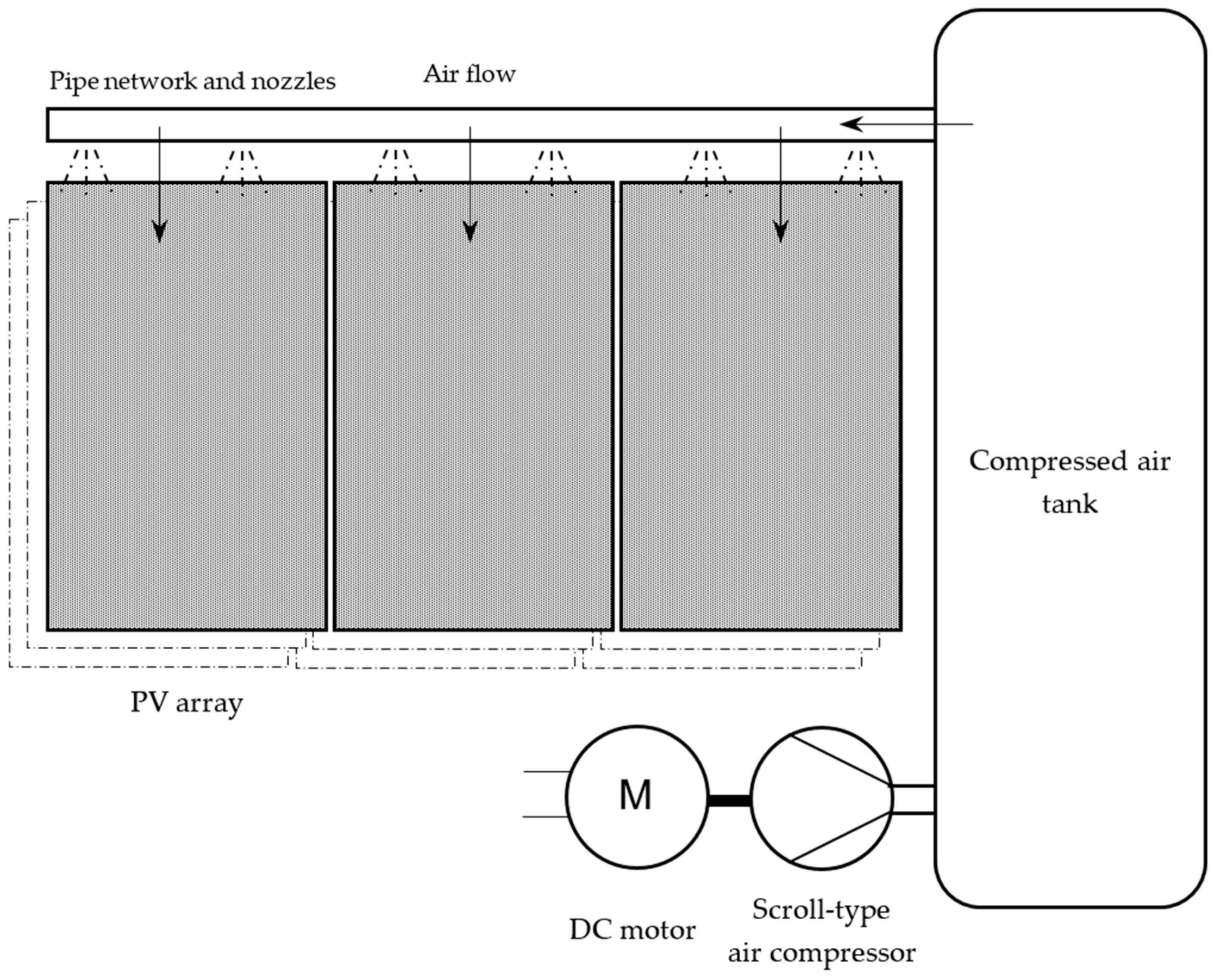


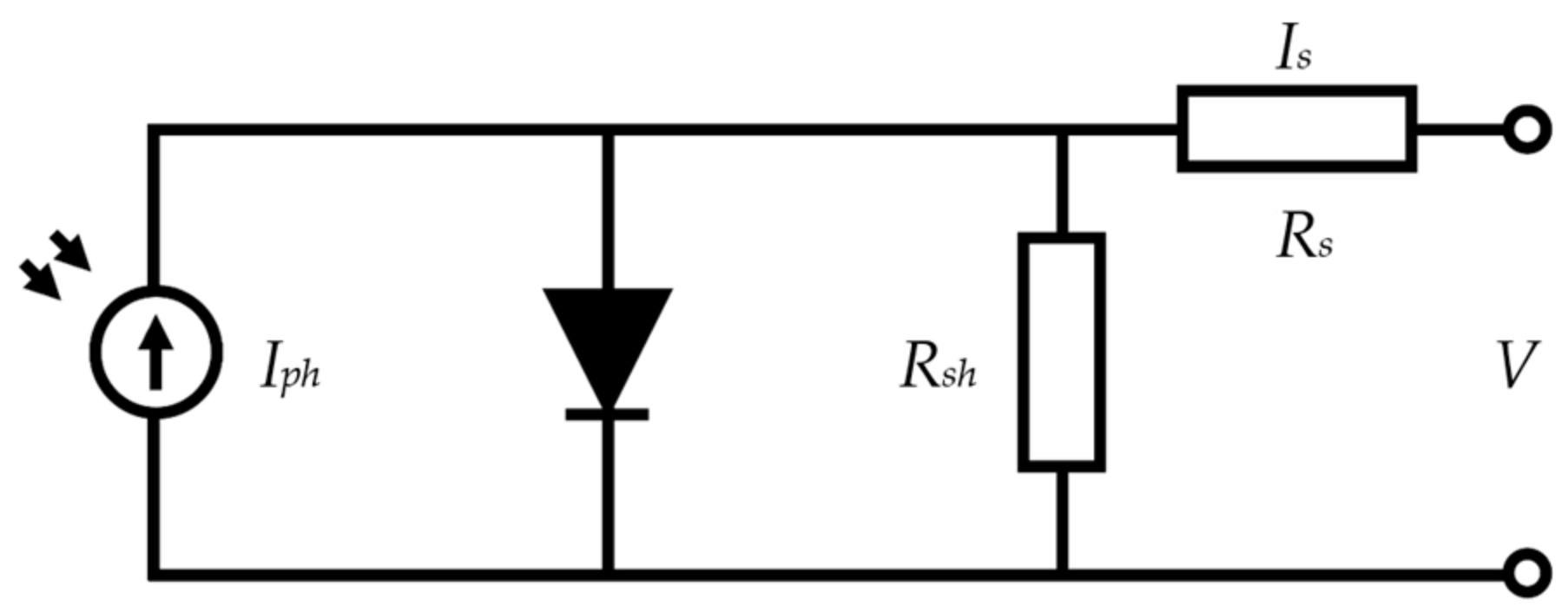
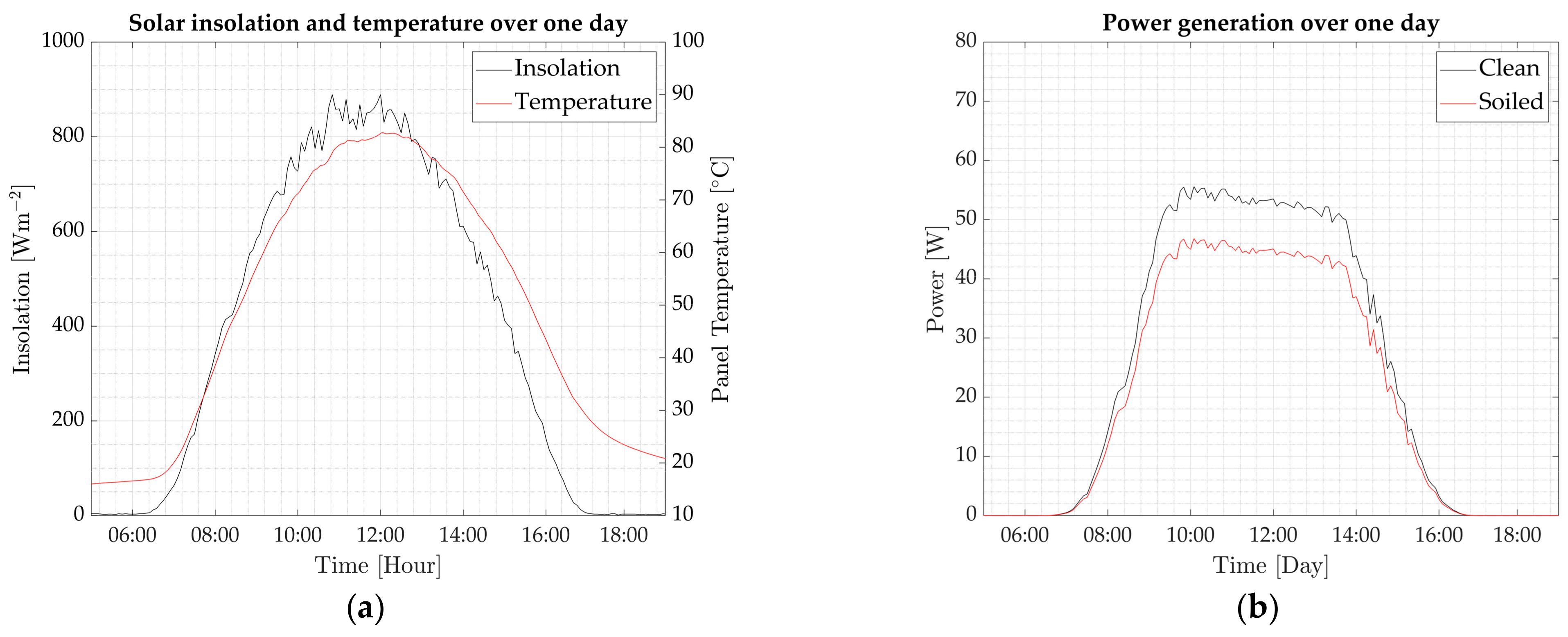
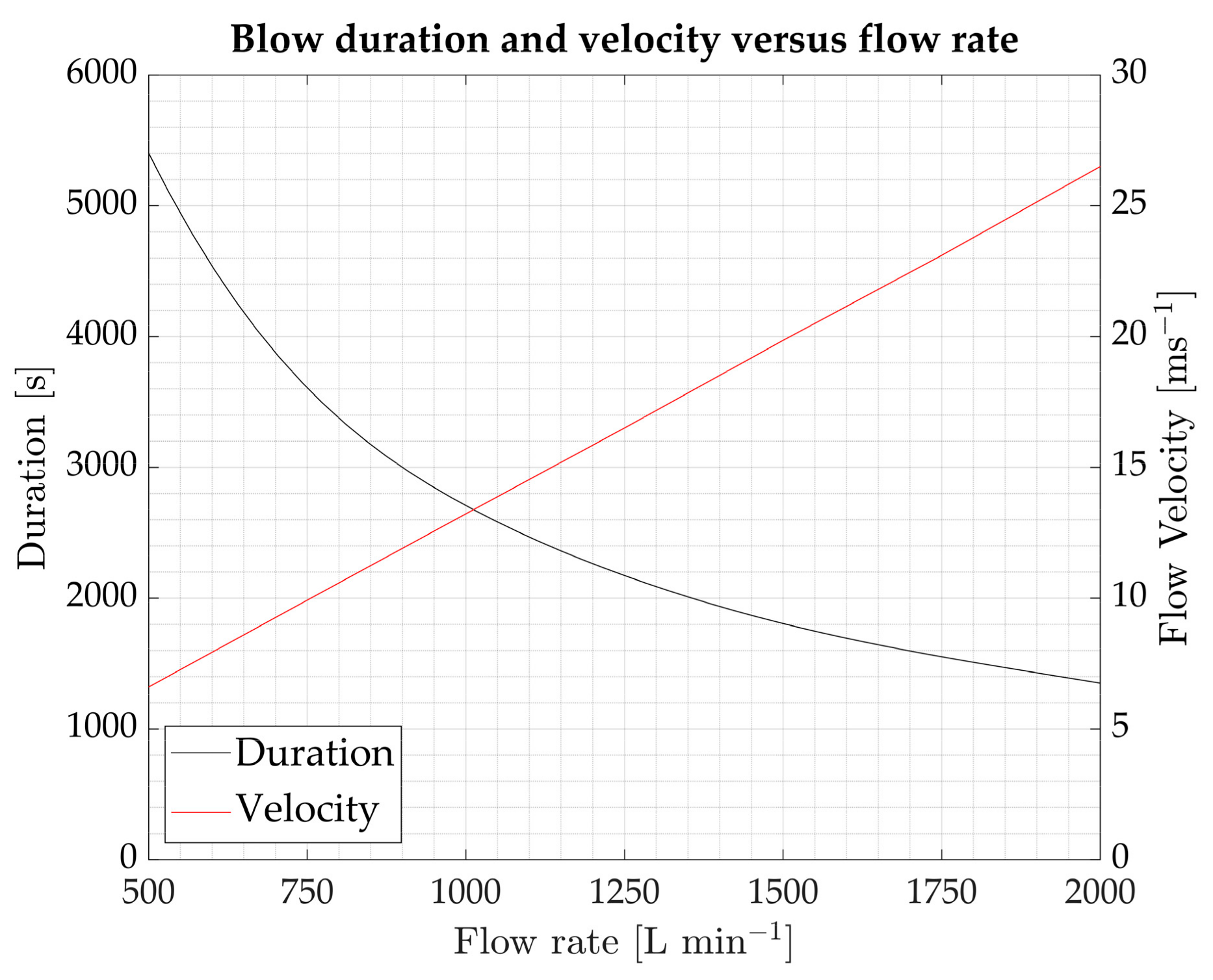
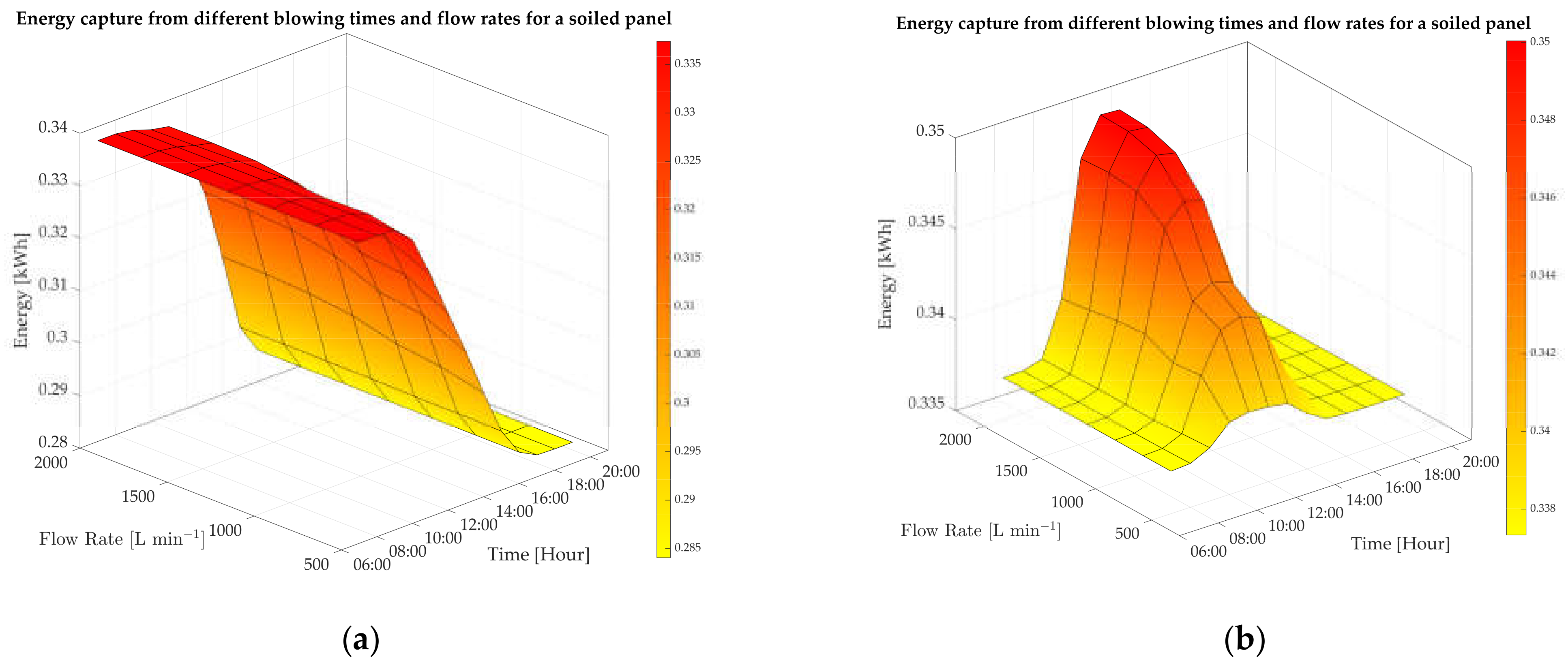
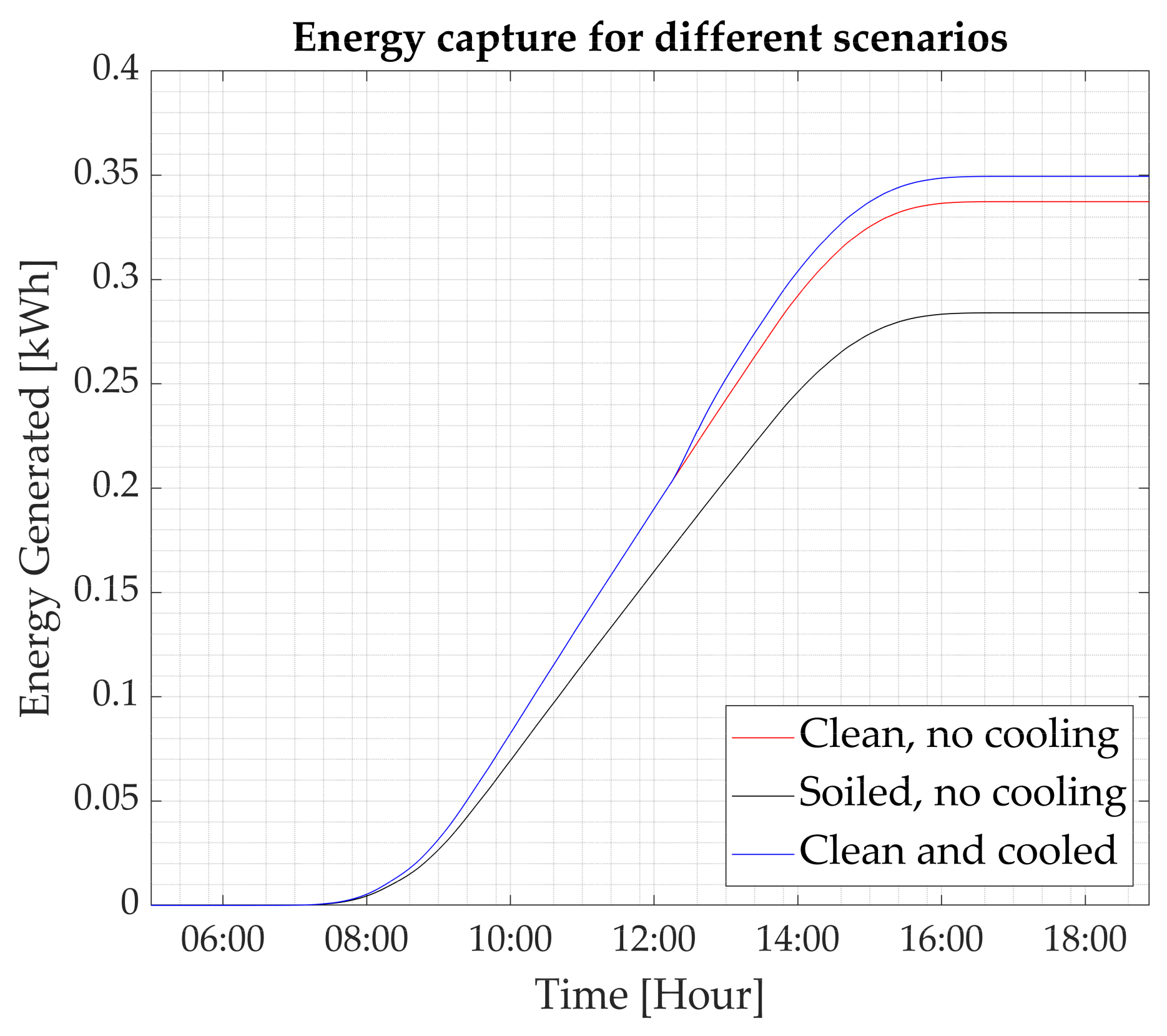
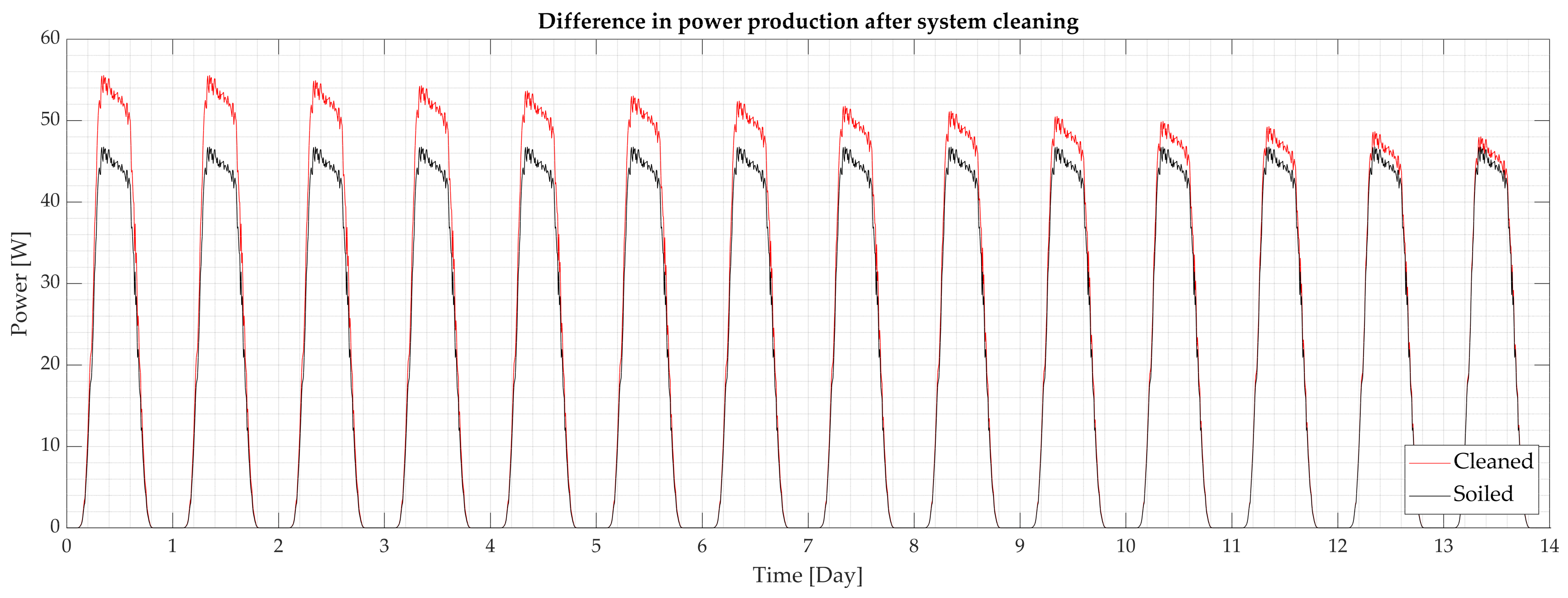
| Energy, Clean ECC [kWh] | Energy, Soiled ES [kWh] | Energy Difference [kWh] | Compressor Energy ECOMP [kWh] | Energy ROI |
|---|---|---|---|---|
| 4.7137 | 4.2608 | 0.4529 | 0.019 | 23.8 |
Publisher’s Note: MDPI stays neutral with regard to jurisdictional claims in published maps and institutional affiliations. |
© 2021 by the authors. Licensee MDPI, Basel, Switzerland. This article is an open access article distributed under the terms and conditions of the Creative Commons Attribution (CC BY) license (https://creativecommons.org/licenses/by/4.0/).
Share and Cite
King, M.; Li, D.; Dooner, M.; Ghosh, S.; Roy, J.N.; Chakraborty, C.; Wang, J. Mathematical Modelling of a System for Solar PV Efficiency Improvement Using Compressed Air for Panel Cleaning and Cooling. Energies 2021, 14, 4072. https://doi.org/10.3390/en14144072
King M, Li D, Dooner M, Ghosh S, Roy JN, Chakraborty C, Wang J. Mathematical Modelling of a System for Solar PV Efficiency Improvement Using Compressed Air for Panel Cleaning and Cooling. Energies. 2021; 14(14):4072. https://doi.org/10.3390/en14144072
Chicago/Turabian StyleKing, Marcus, Dacheng Li, Mark Dooner, Saikat Ghosh, Jatindra Nath Roy, Chandan Chakraborty, and Jihong Wang. 2021. "Mathematical Modelling of a System for Solar PV Efficiency Improvement Using Compressed Air for Panel Cleaning and Cooling" Energies 14, no. 14: 4072. https://doi.org/10.3390/en14144072







